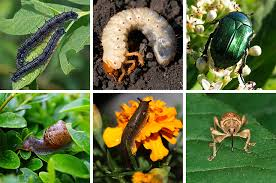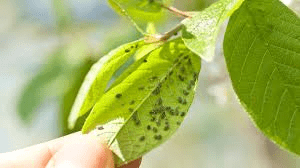Plant pests are organisms that damage crops and plants, reducing their health and productivity. They can be insects, diseases, or weeds, each affecting plants in different ways.
Managing plant pests is crucial for maintaining healthy crops and ensuring a good harvest. This article covers the types of common plant pests, how to identify them, their impact on crops, and preventive measures to control them.
Types of Common Plant Pests
Plant pests can be broadly categorized into three main types: insects, diseases, and weeds. Each type requires different management strategies to effectively control them.
1. Insects
Insects are among the most common plant pests and can cause significant damage to crops. Some common insect pests include:
a. Aphids: Small, soft-bodied insects that suck sap from plants, leading to stunted growth and deformed leaves. They also transmit plant viruses.
b. Caterpillars: The larval stage of moths and butterflies, caterpillars feed on leaves and can cause severe defoliation. Examples include cabbage worms and corn earworms.
c. Whiteflies: Tiny, white flying insects that feed on the underside of leaves, causing wilting and yellowing. They can also transmit diseases.
d. Spider Mites: Very small arachnids that live on the underside of leaves, sucking out plant juices and causing a speckled or stippled appearance.
2. Diseases
Plant diseases are caused by pathogens such as fungi, bacteria, and viruses. They can lead to various symptoms and affect plant health.
a. Fungal Diseases: These include powdery mildew, rusts, and blights. They often cause leaf spots, moldy growths, and premature leaf drop.
b. Bacterial Diseases: Bacteria can cause symptoms like wilting, leaf spots, and cankers. Examples include bacterial blight and crown gall.
c. Viral Diseases: Viruses can cause a range of symptoms, including mosaic patterns on leaves, stunted growth, and poor fruit production. Examples include cucumber mosaic virus and tobacco mosaic virus.
3. Weeds
Weeds are unwanted plants that compete with crops for nutrients, water, and light. They can significantly reduce crop yields.
a. Annual Weeds: These complete their life cycle in one year and often spread quickly. Examples include crabgrass and pigweed.
b. Perennial Weeds: These weeds live for multiple years and can be more challenging to control. Examples include dandelions and bindweed.
c. Biennial Weeds: These weeds complete their life cycle in two years. Examples include wild carrot and burdock.
Read Also: Why Eggs Are Good For You – The Exceptional Super Food for Your Health
Identifying Plant Pests

Correctly identifying plant pests is essential for effective management. Here’s how to recognize them:
1. Signs and Symptoms
Different pests cause distinct symptoms on plants. Observing these signs can help identify the pest:
a. Discoloration: Yellowing, browning, or spotting on leaves may indicate disease or insect damage.
b. Deformation: Misshapen, stunted, or curling leaves can be signs of pest activity.
c. Visible Pests: Insects like aphids or caterpillars may be seen on plants or leaves.
d. Webbing or Mold: Webbing on leaves or moldy growth can indicate spider mites or fungal diseases.
2. Common Pest Damage
Understanding the type of damage pests cause can aid in identification:
a. Chewing Damage: Insects like caterpillars and beetles chew holes in leaves, stems, or fruit.
b. Sucking Damage: Insects like aphids and whiteflies suck plant juices, causing yellowing and wilting.
c. Disease Symptoms: Fungal, bacterial, and viral diseases cause spots, wilting, and unusual growth patterns.
d. Weed Competition: Weeds compete with crops, leading to reduced growth and lower yields.
Read Also: Hookworms: Description, Damages Caused, Control and Preventive Measures
Impact of Plant Pests on Crops

Plant pests can have several adverse effects on crops, impacting both yield and quality.
1. Reduced Yields: Pests can decrease the quantity of crops produced by damaging plants or reducing their ability to grow and develop.
2. Lower Quality: Pests can affect the quality of the harvest, such as causing blemishes on fruits or vegetables, making them less marketable.
3. Increased Costs: Managing plant pests can lead to higher costs for pesticides, herbicides, and other control measures. Additionally, pest damage can reduce the overall profitability of farming.
4. Spread of Diseases: Some pests act as vectors, spreading plant diseases from one plant to another, which can lead to widespread crop losses.
Preventive Measures
Preventing plant pest problems involves a combination of cultural practices, biological control, and other strategies. Here’s how to manage pests effectively:
1. Cultural Practices
Cultural practices involve modifying farming techniques to prevent pest problems:
a. Crop Rotation: Rotate crops each season to prevent pests and diseases from establishing in the soil. Different crops can disrupt the life cycles of pests.
b. Proper Spacing: Space plants properly to improve air circulation and reduce humidity, which can help prevent fungal diseases.
c. Sanitation: Keep the garden or field clean by removing debris, dead plants, and weeds that can harbor pests.
d. Resistant Varieties: Use plant varieties that are resistant to common pests and diseases. This can reduce the likelihood of pest infestations and improve crop health.
2. Biological Control
Biological control involves using natural predators or organisms to manage pests:
a. Beneficial Insects: Introduce beneficial insects such as ladybugs, lacewings, and predatory beetles that feed on harmful pests like aphids and mites.
b. Nematodes: Use beneficial nematodes, which are microscopic worms that attack soil-dwelling pests like root maggots and grubs.
c. Fungal Agents: Apply fungal agents like Beauveria bassiana, which infects and kills various insect pests.
d. Companion Planting: Grow plants that attract beneficial insects or repel pests. For example, planting marigolds can help deter nematodes and attract beneficial insects.
Conclusion
Understanding and managing plant pests is crucial for maintaining healthy crops and maximizing yields. By identifying common pests, recognizing signs of damage, and implementing preventive measures such as cultural practices and biological control, farmers can effectively manage pest problems.
Sustainable pest management not only protects crops but also supports overall farm health and productivity. By staying informed and proactive, growers can safeguard their plants and ensure successful harvests.
Read Also: Complete Composting Guide for Beginners

